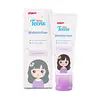What's inside
What's inside
 Key Ingredients
Key Ingredients

 Benefits
Benefits

 Concerns
Concerns

 Ingredients Side-by-side
Ingredients Side-by-side

Water
Skin ConditioningGlycerin
HumectantDimethicone
EmollientBetaine
HumectantButylene Glycol
HumectantPentylene Glycol
Skin ConditioningBisabolol
MaskingCaprylic/Capric Triglyceride
MaskingHydroxyacetophenone
AntioxidantCarbomer
Emulsion StabilisingPolyacrylamide
Tromethamine
BufferingC13-14 Isoparaffin
EmollientAllantoin
Skin ConditioningSodium Hyaluronate
HumectantHydrogenated Lecithin
EmulsifyingAvena Sativa Kernel Extract
AbrasiveAnthemis Nobilis Flower Extract
MaskingLaureth-7
EmulsifyingHydrolyzed Algae Extract
Skin ConditioningDisodium EDTA
Ceramide NP
Skin ConditioningHydrolyzed Collagen
EmollientCaprylyl Glycol
EmollientCaffeine
Skin ConditioningN-Prolyl Palmitoyl Tripeptide-56 Acetate
Skin ConditioningMagnesium Aspartate
Skin ConditioningZinc Gluconate
Skin ConditioningTetrahexyldecyl Ascorbate
AntioxidantPhenoxyethanol
PreservativeCopper Gluconate
Skin Conditioning1,2-Hexanediol
Skin ConditioningWater, Glycerin, Dimethicone, Betaine, Butylene Glycol, Pentylene Glycol, Bisabolol, Caprylic/Capric Triglyceride, Hydroxyacetophenone, Carbomer, Polyacrylamide, Tromethamine, C13-14 Isoparaffin, Allantoin, Sodium Hyaluronate, Hydrogenated Lecithin, Avena Sativa Kernel Extract, Anthemis Nobilis Flower Extract, Laureth-7, Hydrolyzed Algae Extract, Disodium EDTA, Ceramide NP, Hydrolyzed Collagen, Caprylyl Glycol, Caffeine, N-Prolyl Palmitoyl Tripeptide-56 Acetate, Magnesium Aspartate, Zinc Gluconate, Tetrahexyldecyl Ascorbate, Phenoxyethanol, Copper Gluconate, 1,2-Hexanediol
Water
Skin ConditioningParaffinum Liquidum
EmollientGlycerin
HumectantSimmondsia Chinensis Seed Oil
EmollientBehenyl Alcohol
EmollientGlyceryl Stearate
EmollientSqualane
EmollientStearic Acid
CleansingPhenoxyethanol
PreservativeSodium Stearoyl Glutamate
CleansingCarbomer
Emulsion StabilisingMethylparaben
PreservativePentylene Glycol
Skin ConditioningMethylpropanediol
SolventSodium Lactate
BufferingLactic Acid
BufferingSerine
MaskingUrea
BufferingSorbitol
HumectantButylparaben
MaskingEthylparaben
PreservativeParfum
MaskingPropylparaben
PreservativeSodium Chloride
MaskingChamomilla Recutita Extract
Skin ConditioningAllantoin
Skin ConditioningWater, Paraffinum Liquidum, Glycerin, Simmondsia Chinensis Seed Oil, Behenyl Alcohol, Glyceryl Stearate, Squalane, Stearic Acid, Phenoxyethanol, Sodium Stearoyl Glutamate, Carbomer, Methylparaben, Pentylene Glycol, Methylpropanediol, Sodium Lactate, Lactic Acid, Serine, Urea, Sorbitol, Butylparaben, Ethylparaben, Parfum, Propylparaben, Sodium Chloride, Chamomilla Recutita Extract, Allantoin
Ingredients Explained
These ingredients are found in both products.
Ingredients higher up in an ingredient list are typically present in a larger amount.
Allantoin is a soothing ingredient known for its protective and moisturizingg properties. Because of this, it is often added to products with strong active ingredients.
Studies show higher concentrations of this ingredient can promote wound healing.
Though it can be derived from the comfrey plant, allantoin is produced synthetically for cosmetic products to ensure purity.
Learn more about AllantoinCarbomer is a polymer of acrylic acid. Its main role is to create a gel consistency.
A high amount of carbomer can cause pilling or balling up of products. Don't worry, most products contain 1% or less of carbomer.
Glycerin is already naturally found in your skin. It helps moisturize and protect your skin.
A study from 2016 found glycerin to be more effective as a humectant than AHAs and hyaluronic acid.
As a humectant, it helps the skin stay hydrated by pulling moisture to your skin. The low molecular weight of glycerin allows it to pull moisture into the deeper layers of your skin.
Hydrated skin improves your skin barrier; Your skin barrier helps protect against irritants and bacteria.
Glycerin has also been found to have antimicrobial and antiviral properties. Due to these properties, glycerin is often used in wound and burn treatments.
In cosmetics, glycerin is usually derived from plants such as soybean or palm. However, it can also be sourced from animals, such as tallow or animal fat.
This ingredient is organic, colorless, odorless, and non-toxic.
Glycerin is the name for this ingredient in American English. British English uses Glycerol/Glycerine.
Learn more about GlycerinPentylene glycol is typically used within a product to thicken it. It also adds a smooth, soft, and moisturizing feel to the product. It is naturally found in plants such as sugar beets.
The hydrophilic trait of Pentylene Glycol makes it a humectant. As a humectant, Pentylene Glycol helps draw moisture from the air to your skin. This can help keep your skin hydrated.
This property also makes Pentylene Glycol a great texture enhancer. It can also help thicken or stabilize a product.
Pentylene Glycol also acts as a mild preservative and helps to keep a product microbe-free.
Some people may experience mild eye and skin irritation from Pentylene Glycol. We always recommend speaking with a professional about using this ingredient in your routine.
Pentylene Glycol has a low molecular weight and is part of the 1,2-glycol family.
Learn more about Pentylene GlycolPhenoxyethanol is a preservative that has germicide, antimicrobial, and aromatic properties. Studies show that phenoxyethanol can prevent microbial growth. By itself, it has a scent that is similar to that of a rose.
It's often used in formulations along with Caprylyl Glycol to preserve the shelf life of products.
Water. It's the most common cosmetic ingredient of all. You'll usually see it at the top of ingredient lists, meaning that it makes up the largest part of the product.
So why is it so popular? Water most often acts as a solvent - this means that it helps dissolve other ingredients into the formulation.
You'll also recognize water as that liquid we all need to stay alive. If you see this, drink a glass of water. Stay hydrated!
Learn more about Water